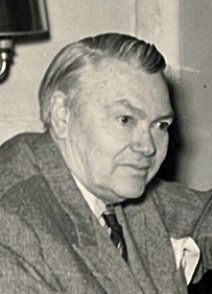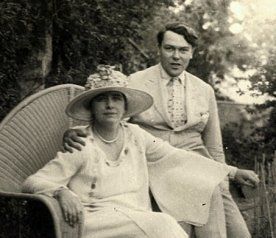Timothy Mather Spelman
Timothy Mather Spelman was born 21 January 1891 in Brooklyn (NY, USA). He went to the Polytechnic Preparatory School in Brooklyn and then studied music with Harry Rowe Shelley, and at Harvard under Walter Raymond Spalding (composition) and Edward Burlingame Hill (orchestration).
In 1913 he was awarded the Elkan Naumburg Fellowship in Music and studied with Walter Courvosier at the Conservatory in Munich until the outbreak of war in 1914. Timothy Mather Spelman returned to New York where he worked on his own compositions, taught musical theory, and gave lecture recitals on the history of opera. At that time he married the writer Leolyn Louise Everett. In 1917 Timothy Mather Spelman was called to Washington to serve as assistant director of Band Musicians' Training in the War Department under Wallace Goodrich. But in 1919 the Spelmans moved to Florence (Italy), leased and later bought the Villa Razzolini which became their home for the rest of their lifes. They only left Italy for the time of World War II when the Spelmans came back to the US. They returned to the villa in 1947 where they continued restoration work on the house and its gardens as well as composing and writing. Timothy Mather Spelman died on 21 August 1970 in Florence (Italy).
The first compositions of Timothy Mather Spelman date from the time around 1910. His melodram "How Fair, How Fresh Were the Roses" was performed in Brooklyn in 1909. The later works found even larger audiences: The symphonic poem "Christ and the Blind Man" was premiered by the Chicago Symphony Orchestra under Frederick Stock in March 1923, the orchestral suite "Barbaresques" by Sir Henry Wood and the Queen's Hall Orchestra in London in 1924 and the "Saints' Days" by the Boston Symphony Orchestra under Serge Koussevitzky.
Other compositions by Timothy Mather Spelman include the operas "La Magnifica", "The Sea Rovers" and "Miles Standish", a symphony, an oboe concerto, a piano sonata, a string quartet, the choral works "Pervigilium Veneris" and the cantata "Litany of the Middle Ages" as well as many other chamber compositions and songs.
In my posession are a few autograph music manuscripts and printed scores of works by Timothy Mather Spelman. My small archive includes:
1) Saints' Days, for orchestra
The work was composed between 1923 and 1925 and consists of the 4 movements I. Sorrento; II. Venice - The Festival of the Redeemer; III. Siena - The Palio; IV. Assisi - The Great Pardon of Saint Francis.
The premiere of last movement "Assisi" was on 26 March 1926 by no one less than the Boston Symphony Orchestra under Serge Koussevitzky. The first complete performance of the orchestral version was done by the Orchestre Straram under Walther Straram in Paris on 21 February 1929.
Part of my archive are the autograph manuscript of the piano reduction of "Saints' Days" as well as the printed full score published by J. & W. Chester in 1926. The printed score comes from the library of Walther Straram and has a handwritten dedication by Timothy Mather Spelman on the title page that dates from August 1928. It also contains autograph tempi markings for each movement by Mather Spelman that are missing in the printed score. The score is accompanied by a handwritten letter by Mather Spelman from 4 September 1928.
2) Opera "The Sea-Rovers"
Autograph manuscript of the piano reduction of all three acts. In addition the privately bound typoscript of the libretto which was written by Leolyn Louise Everett, the spouse of Timothy Mather Spelman. The work was composed in 1928, but not published and as far as I know never performed since this day.
Below one can find the libretto of "The Sea-Rovers" and the score of the first act in the piano reduction for information purposes:
3) Quartetto in Re maggiore per Archi
Published study score of the String quartet by Timothy Mather Spelman. The work was composed in 1953 and published the same year by the Italian publishing house Edizioni Suvini Zerboni. My copy has an autograph inscription by Timothy Mather Spelman to the poet Rene Chalupt (1885-1957): "To our dear Rene Chalupt from Leolyn, to whom this work is dedicated, and from Tim - Christmas 1954".
4) La Magnifica
Published score of opera "La Magnifica" in the piano reduction published by J. & W. Chester in 1924. The score comes from the library of Walther Straram. It contains a handwritten dedication to Straram from Mather Spelman on the title page that dates from November 1928. The copy also includes the complete Franch translation of the text written by Mather Spelman by hand directly into the score.
5) Christ an the Blind Man, for orchestra
Published copies of both the full score as well as the piano reduction. Both versions were published in 1921 by Novello/Gray Company and both copies have autograph inscriptions by the composer to Walther Straram that date from 1933. The scores contain several handwritten corrections by Mather Spelman and the note "Partition corrigee" on the cover.
6) Fauns at Prayer
Published book of poems by Leolyn Louise Everett. The book was published by John Lane The Bodley Head Limited in London in 1922. My copy has an autograph inscription of the author: "For Rene Chalupt - with friendship and appreciation - Leolyn Louise Everett Spelman - Paris, February 28th, 1925".


© pictures: with kind permission of the Sheridan Libraries of the Johns Hopkins University